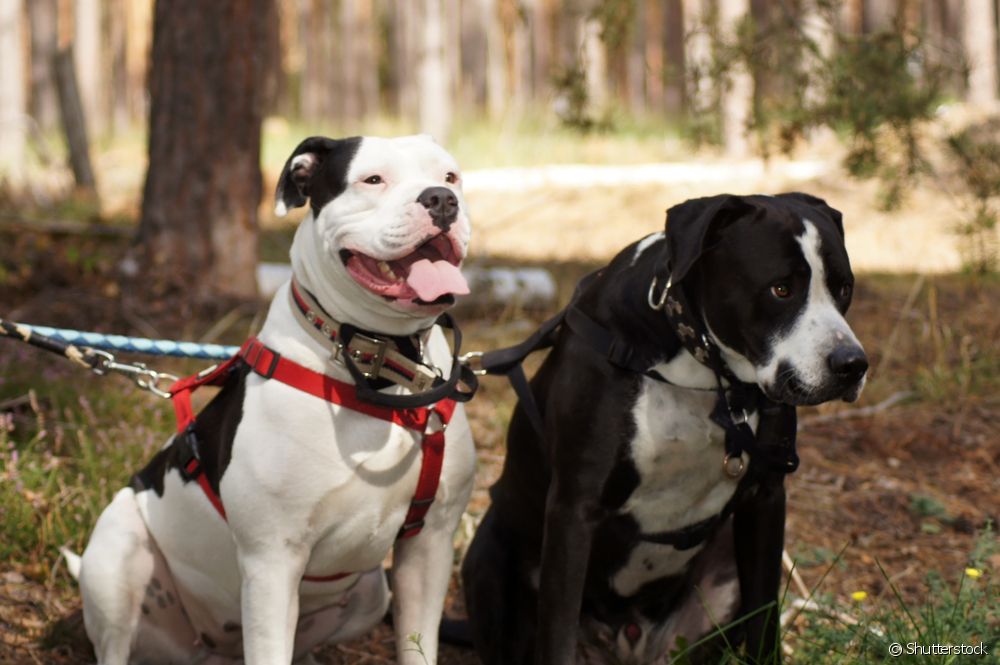Dog that pulls on the walk: 6 tricks to improve the pace

Table of contents
A walk is the happiest time for a dog and some know exactly when to leave the house. This joy, however, can turn into a lot of anxiety and agitation: and a common reaction to this behavior is to pull on the collar and leash. The walk needs to be enjoyable for the dog and its owner! Many owners end up giving up walking the street with their dog because of the difficulty, but theThe truth is that this makes the situation worse and can make him even more anxious. Daily walks are essential for the physical and psychological health of dogs. This is when they exercise, interact with other animals, smell various smells and explore different places.
See_also: 7 things you need to teach your puppy in the first months of lifeLearn how to train your dog and put an end to pulling!
Stopping the pulling is a process that requires a lot of patience and correct techniques. We know that the frustration of a walk with pulling is great, but stopping them is a process that requires dedication. Therefore, we have prepared a material with 6 tips on how to train your dog to be calmer outside the home. Enough more!
1 - Start training at home
Training with your dog should take place at a quieter time. It is no use putting on the collar and leash and already wanting him to be less anxious for the walk. It is much better to do the training after returning from the street than before, as the puppy will be more tired and this will facilitate the process. A tip to attract the dog's attention is to make meals a time of attention.training: for every hit, a grain of feed.
Home training is simple and doesn't need to last more than 10 minutes. Place your dog next to you on a leash and start walking around the room. Take two steps and, if he doesn't pull, reward him with a grain of food or a treat. Repeat several times, moving on to other rooms in the house, until he can make a longer distance on a loose leash. When the training is overIf your dog is working indoors, try moving on to other places, such as the hallway or backyard. If he gets agitated and starts pulling, go back.
2 - Dog collar and lead: have the right accessories
The type of collar you use for the walk can also influence the pulling. The neck collar, for example, is suitable for weaker dogs. For those who have more strength, it is recommended to use a chest collar that attaches the dog leash to the front (avoid the models with the buckle on the back, as this will make the dog have more control of the walk than you). With thisanti-pulling harness, you work on the dog's frustration: when he tries to go out shooting, he will automatically be taken to the side and will not be able to move forward.
Some people resort to the halter model (which holds the muzzle and is good for more aggressive dogs) and the hangman. But beware! The use of both is indicated only by people who have a lot of experience with walks, as they can hurt the dog.

3 - Tire the dog out before the walk
An alternative to slowing down your dog's pace on the walk is to play a lot before going out. Throw the ball, make him run around the house, encourage play: anything goes to make him less anxious. More tired, he may be less agitated and not pull on the leash.
4 - Get your dog frustrated when he tries to pull on the lead
When your dog starts pulling on the leash, simply stop the walk with the leash on your body and don't take any more steps. Ideally, soon afterwards your dog will "realize" that this behavior is not cool and loosen the leash. At first, you will have to repeat this several times until it works. Try to do this training in places with little movement of people or at quieter times,such as early in the morning or late at night.
Another tip is to simply turn around and head in the opposite direction. Over time, these little frustrations will make your dog understand that every time he pulls, the walk will be interrupted. It is important that you are very judicious during these trainings and really don't reward wrong behaviors.
5 - Use treats and other rewards when he walks properly
Dogs love rewards, and a good way is to teach them to associate treats with good behavior. Whenever they pace and loosen their leash, give them lots of praise or a tasty treat. You can also allow them to sniff a post or "greet" another dog when they're walking without pulling.
6 - Keep control of the ride
Your dog needs to understand that it is you who will guide the walk. With the help of the treat, you can teach your puppy the meaning of "together". Whenever he is walking next to you and without pulling, use the command. It is advisable not to talk during the pulls, as he may think he is getting it right, when in fact he is doing everything wrong.
Extra Tip: Training can help you a lot to put all these tricks into practice if you can't solve the problem yourself - yes, some dogs are very difficult to control. Seek out trusted professionals and explain the situation, so he will determine the best technique to correct the behavior. And never forget that your puppy does not yet know all things and needs toof you to teach him. Have patience and lots of love!
See_also: Does your dog have bruxism? Veterinarian explains more about teeth grinding
